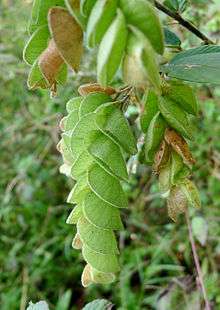Flemingia strobilifera
| Flemingia strobilifera | |
|---|---|
 | |
| Flemingia strobilifera | |
| Scientific classification | |
| Kingdom: | Plantae |
| (unranked): | Angiosperms |
| (unranked): | Eudicots |
| (unranked): | Rosids |
| Order: | Fabales |
| Family: | Fabaceae |
| Subfamily: | Faboideae |
| Tribe: | Phaseoleae |
| Subtribe: | Cajaninae |
| Genus: | Flemingia |
| Species: | F. strobilifera |
| Binomial name | |
| Flemingia strobilifera (L.) W. T. Aiton[1] | |
| Synonyms | |
| |
Flemingia strobilifera is a flowering plant in the legume family, Fabaceae. It belongs to the sub family Faboideae. Flemingia strobilifera is native to Eastern Asia. It is common in China, Taiwan, Bhutan, India, Nepal, Pakistan, Sri Lanka, Laos, Myanmar; Thailand, Vietnam, Indonesia, Malaysia, Papua New Guinea and Philippines.[1]
It is known as makhiyoti (মাখিয়তী) in the north-eastern Indian state of Assam. It is an essential part of the Bihu (গৰু বিহু) festival, during which the cattle are washed and gently beaten with twigs of this plant.[3]
-

Flemingia strobilifera found in Panchkhal valley
-

Dry flower which lasts for a long time
References
- 1 2 Flemingia strobilifera (L.) W. T. Aiton, GRIN
- ↑ http://www.theplantlist.org/tpl/record/ild-41472
- ↑ Flemingia strobilifera (L.) R. Br.
This article is issued from Wikipedia - version of the 6/9/2015. The text is available under the Creative Commons Attribution/Share Alike but additional terms may apply for the media files.
